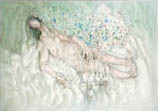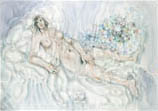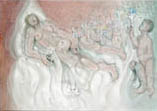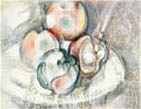exhibition programme | paintings | tapestries | prints | chronology of a life | market | biography & bibliography | agents | news
2006. Celebrations
Ninetieth birthday celebrations. Eleven one-person exhibitions and numerous events organised. The Irish Times reports: 'Louis le Brocquy, the elder statesman of Irish art, is currently the subject of a number of celebratory exhibitions and events to mark his ninetieth birthday, not only in Ireland but also in Paris and London. The celebrations and accolades have been well-earned after more than seven decades during which this self-taught artist has come to be recognised both at home and internationally as the foremost Irish painter of the 20th century.'332 Exhibitions include the Irish Museum of Modern Art; Gimpel Fils, London; Dublin City Gallery The Hugh Lane; Tate Britain, London; Galerie Jeanne-Bucher, Paris; Crawford Art Gallery, Cork. The National Gallery of Ireland will host the first exhibition ever held by a living artist. The Hunt Museum, Limerick curtates the first comprehensive exhibition dedicated to the artist's 'Tinker' period paintings. Dr Yvonne Scott remarks: 'Never before has such an extensive selection from this series been shown together at any one time, and included are major, iconic works such as Tinker Woman with Newspaper, Man Creating Bird, In Fear of Cain, and the tapestries Irish Tinkers and Garlanded Goat... It may seem somewhat surprising that the sub-title of the show, Allegory and Legend, should apply to works from the Travellers series given the harsh reality of the way of life which prompted the artist's response. However, le Brocquy was attracted to the theme also for its allegorical elements with which he identified personally as an artist, and he was particularly fascinated by the esoteric nature of the rituals and practices. Most especially, in his experience, the very earthiness of the lifestyle, the seeming closeness to nature and lack of inhibition, placed the Travellers at the fundamentals of existence which have spawned the originally myths of creation, procreation and death as exemplified in the themes represented in this show. By bringing such a large range together, with the Travellers series as the centrepiece, an opportunity is afforded of exploring the way these works are conceptually interlinked, demonstrating the coherence as well as the creative range, across Louis le Brocquy's long and fruitful career... In particular, it may prompt further evaluations of the complexity and interconnectedness of these and of those other themes in the oeuvre of this prodigious artist'333 Edel Casey of Apollo Magazine writes: 'Louis le Brocquy: Allegory and Legend at the Hunt Museum, Limerick, Ireland, is one in a series of international exhibitions that are celebrating the 90th year of Louis le Brocquy, whose stature in his native country is suggested by the fact that he is the only living artist represented in the National Gallery of Ireland [Permanent Collection]. Curated by the artist's son, Pierre le Brocquy, and Virginia Teehan, the director of the Hunt museum, it includes a selection from le Brocquy's 'Tinker' series, the Eden and Cúchulainn Tapestries, the Procession paintings and the Táin lithographs. The close collaboration between the museum and le Brocquy's family has created a commendable exhibition, which is accompanied by a searching and well-illustrated catalogue... This is the first opportunity to view together a large part of the Tinker series, which represents the Irish travelling community; 20 examples, created between 1945 and 1950, are on show. The name 'Tinker', once used to describe the travellers, is derived from their former traditional trade in making and repairing utensils from tin while living a nomadic life by the roadside. In 1945, while working in the Irish midlands town of Tullamore, Co. Offaly, le Brocquy was inspired by an encampment of travellers to create sketches and vibrant watercolours of them. In 1946, after moving to London, he returned to the subject in oil paintings influenced by Picasso's cubism... Travelling Woman with Newspaper is often described as the masterpiece of the series. In the context of Irish art its importance lies in the depiction of the travelling woman as a dominating figure, in contrast to traditional representations of women in a submissive capacity. By crushing the newspaper, she symbolically rejects the settled, bourgeois society that it represents. As well as embodying the traveller's isolation and individualism, the work may also reflect le Brocquy's attitude as a modernist artist to traditional artists and critics in Ireland. This work may have influenced William De Kooning's [sic] treatment of women, as he saw le Brocquy's work in 1948-49 in Amsterdam at an exhibition 'Twelve Contemporary British Painters'. Le Brocquy was deeply sensitive to the travellers' culture and history. In Tinkers Making Twig Sign (1946) and Tinkers Break Whitethorn he reveals his interest in the ritual aspects of their culture. Twig signs were usually made to leave good messages or warn of oncoming dangers or to leave a curse on the settled community when leaving an encampment... The exhibition highlights what Yvonne Scott describes, in her enlightening introductory essay for the catalogue, as le Brocquy's 'cosmological philosophical' awareness.'334 Included in A Time and A Place: two centuries of Irish social life, National Gallery of Ireland (2006); Irish Art of the Seventies, Irish Museum of Modern Art (2006); Louis le Brocquy; Selected work from the IMMA Collection, Ballinskelligs, Cill Rialaig Arts Centre (2006); Ten Years in the Making. 'An Exhibition of art from State Buildings 1995 - 2005', Farmleigh Gallery, Dublin (2006); Connected - Unconnected, The Dock Centre, Carrick on Shannon, Co. Leitrim (2006); The Borrowing, Irish Museum of Modern Art - IMMA (2006); Samuel Beckett A Passion for Painting, National Gallery of Ireland (2006). The artist pursues work on his 'Homage' paintings. Manet's Olympia is once again revisited. Following Odalisque I. Looking at Manet. Olympia, 2005 (AR764), the artist completes three further versions. James Hamilton remarks: 'Although he began with Manet's Olympia as the source, le Brocquy moves outwards in the Odalisques through his own experience as a painter, drawing on a reservoir of insight accumulated over a lifetime. The ripples which unify the Odalisque canvases, and mingle image and background, are continuations of the meandering lines which the young le Brocquy made in pencil and pastel drawings of lovers in 1943 and 1944. There is a clear thread joining le Brocquy's early work to these late statements, whose line can be traced more or less clearly as it dips and rises, sharpens and softens, across the intervening sixty or seventy years... The figure in le Brocquy's Odalisques conjures a sequence of moods, conveyed through colour variations and amendments of pose and staffage - woman, cat, boy, flowers. Odalisque I (AR764) is alert, lying naked on her bed against a modulated rich green background. Her fingers are in sensitive tactile motion, suggested by filmy, equivocal paintwork, and the flower bunch by her left leg makes a painterly burst of red, blue, white and yellow. She has a wide-awake erotic charge, the ripples playing across the picture surface suggesting that she may be lying not on a bed, but in the shallow end of a warm, inviting swimming-pool. Odalisque II (AR770), the most overtly sexual of the group, is fast asleep and, with her elongated neck and thrown back head, evidently dreams with flowers that are now not a bunch, but a river flowing luxuriously around her. In Odalisque III (AR772), we see an explosion of summer flowers. The woman is sitting upright, awake and aware, with intense green eyes looking slightly to the left of the viewer; the cat sleeps. The last of the quartet, Odalisque IV (AR773) is asleep, and visited by a small naked boy who gives her flowers. The cat beside her is quietly watchful. There is a voluptuous pink tonality here, the body and bedclothes interpenetrating, and the whole articulated by gauzy red and pink flowing crayon marks. Fluid lines circle round and round to create, gently and lovingly, the form of legs, arms and breasts.'335 The cycle of 'Homage' paintings are exhibited at Gimpel Fils, London (November 2006), Louis le Brocquy. Homage to his Masters, eight works, Tom Rosenthal reports in The Spectator: 'Louis le Brocquy is 90 this year and his new show at Gimpel's is merely one of four current celebratory exhibitions. (The others are at Tate Britain, The National Gallery of Ireland and Galerie Jeanne Bucher in Paris.) He once wryly observed: 'I'm aware that my age and vulnerability could be mistaken for some kind of authority.' While the Gimpel show of his latest work does not in any way claim authority it also fails to exhibit any vulnerability. The whole subject of homage versus imitation could spark a book and here he gives us four homages to Manet's 'Olympia' - which after all is not only an independent masterpiece but also a homage to Titian's 'Venus of Urbino' and has echoes of both Giorgione and Ingres. Of course it's a universal subject, and le Brocquy brings to it a vigour and a freshness of approach which enable this timeless temptress to seduce our contemporary eyes. There's no question of imitation; no trace of the studious copyist sitting on a collapsible chair in a museum. Here the nonagenarian is still playing games with the past; Manet's female attendant has turned into a small boy (Cupid? ), the flowers change shape in form and size in each of four variations and the large cat is a mischievous and selfsatisfied onlooker who has strayed not only from Manet but also from le Brocquy's own great 1951 painting 'A Family', also a tribute to Manet, now in the Dublin National Gallery. The nude, while possessing all of Manet's model's cool, unabashed eroticism, is wholly of today, more careless, more relaxed and far less perfect of physique. His homage to Cézanne, a tiny 'Four Apples and a Knife' (AR771), is only a compliment to the subject matter. The technique is wholly le Brocquy's, in the soft pastel colours and the careful use of white and the texture of the canvas. But it's when you compare his Spanish-inspired pictures with, say, Picasso's variations on Velázquez's 'Las Meninas' that you see that Picasso's dazzling jiggery-pokery with shapes and forms is ultimately less satisfying than le Brocquy's analytical transpositions in which, while the sophistication of the paint is as subtle as ever, it is the human element which predominates. His version of Velázquez's 'The Dwarf Don Sebastián de Mora' (AR767) gives him a grace and dignity which are wholly compelling and the setting, in the multi-layered fabrics of his clothes, arranged around him like an angel's wings, lingers in the memory.'336 In Ireland, President Mary McAleese pays tribute to the artist.'337 A documentary, Louis le Brocquy, The Inner Human Reality, directed by Joe Mulholland, is broadcasted on Irish television.338 Conferred Honorary Associate, National College of Art and Design, Dublin, 2006.
332 Second leader, 'Le Brocquy at 90', The Irish Times (Dublin: November 4, 2006).
333 Yvonne Scott, ‘Louis le Brocquy, Allegory and legend’, exhibition catalogue, The Hunt Museum, Limerick, June - September 2006.
334 Edel Casey, ‘ ‘Ninety years young’, Apollo Magazine (London, September 2006).
335 James Hamilton, 'Ireland's Prospero of Painting: Celebrating the Sixty Year Partnership between Louis le Brocquy and Gimpel Fils', exhibition catalogue, Louis le Brocquy. Homage to his Masters, Gimpel Fils, London, November 24 -January 13, 2007.
336 Rosenthal, Tom, ‘Playing with the past’, The Spectator (London, December 2, 2006)
337 Christine Newman, ‘Artist thanked for “wonderful work”.’ The Irish Times (Dublin, October 28, 2006).
Odalisque II
Looking at Manet. Olympia, 2006
oil on canvas- 114 x 162 cm- AR770
Odalisque III
Looking at Manet. Olympia, 2006
oil on canvas, 114 x 162 cm, AR772
Odalisque IV
Looking at Manet. Olympia, 2006
oil on canvas, 114 x 162 cm, AR773
Looking at Cezanne
Four Apples and a Knife, 2005
oil on canvas, 20 x 26 cm, AR771



